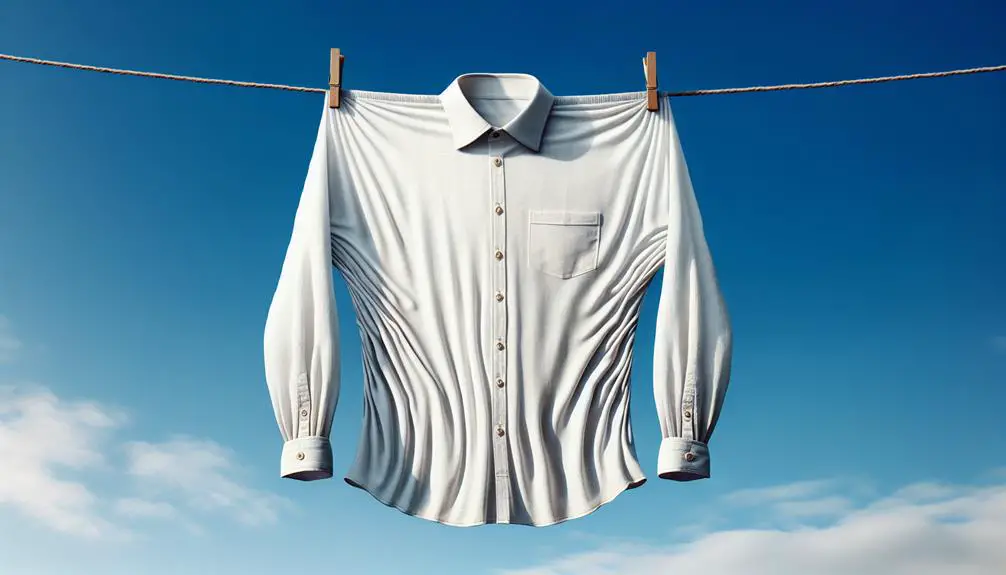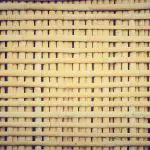Yep, linen can shrink a bit after a wash, usually around 4% to 10%. But don't stress, right? If you take care when washing and stick to the care instructions, you can help lessen the shrinkage happening over time. Remember, things like using cold water and air drying can be your linen's best buddies. So, if you want to know more helpful tips and tricks on how to keep your linen looking fresh and fabulous, keep on checking out ways to care for your beloved linen pieces.
Table of Contents
Key Takeaways
- Linen can shrink 4% to 10% after washing due to relaxation shrinkage.
- Pre-washed linen or cold water washing minimizes shrinkage.
- Avoid high heat settings in washing and drying to reduce size changes.
- Following care instructions and proper drying methods prevents excessive shrinkage.
- Reshape and stretch linen while damp to recover some shrinkage.
Understanding Linen Shrinkage
When we discuss understanding linen shrinkage, it's important to grasp how this natural phenomenon impacts the size of our beloved linen clothes. Linen, derived from flax fibers, undergoes what's known as relaxation shrinkage, where the fibers contract during the initial wash cycle. This process can cause your linen garments to shrink by about 4%, sometimes even up to 10%.
To mitigate this, choosing pre-washed linen items can help reduce the extent of shrinkage. Additionally, providing proper care to your linen pieces by following care instructions, such as washing in cold water and avoiding high heat in the dryer, can also assist in minimizing shrinkage over time.
Factors Affecting Linen Shrinkage
Factors like water temperature and heat settings influence the shrinkage of linen garments, with high temperatures from washing or drying potentially leading to more significant changes in size. It is crucial to pay attention to these factors when caring for your linen pieces to avoid unexpected shrinkage. Below is a table summarizing how water temperature and heat settings can impact the shrinkage of linen:
| Factors | Impact on Linen Shrinkage |
|---|---|
| Water Temperature | High temperatures can cause more shrinkage. |
| Heat Settings | High heat settings in the dryer can lead to significant changes in size. |
| Washing Instructions | Following the proper washing instructions can help prevent excessive shrinkage. |
Proper Washing Techniques for Linen
After comprehending how factors like water temperature and heat settings can impact the shrinkage of linen garments, it's crucial to focus on employing proper washing techniques to maintain the size and quality of your linen items. When washing linen, always check the care instructions provided by the manufacturer. These instructions are tailored to the specific type of linen fabric and can help you avoid unnecessary shrinkage.
It's best to use cold water and a gentle cycle when washing linen to prevent excessive shrinking, as high heat settings can cause more significant shrinkage in this fabric.
To guarantee your linen items stay in top condition, consider opting for pre-washed or pre-shrunk linen options. These have already gone through the shrinking process, so you won't be in for any surprises post-wash. By following these simple washing techniques and care instructions, you can maintain the size and quality of your linen garments for a long time.
Drying Methods for Minimizing Shrinkage
To minimize shrinkage when drying linen items, consider hang drying them instead of using a dryer. Hang drying is gentler on the fabric and can help maintain the shape and size of your linen pieces. Direct sunlight can be beneficial, especially for whites and light-colored linens, as it can have a slight bleaching effect and help remove stains naturally. Always check the care instructions provided by the manufacturer to prevent any excessive shrinkage. Additionally, avoid using fabric softener, as linen naturally softens with each wash, reducing the risk of shrinkage.
Here is a table summarizing key points for drying linen items effectively:
| Drying Method | Benefits | Additional Tips |
|---|---|---|
| Hang Drying | Minimizes shrinkage | Check care instructions |
| Sun Exposure | Bleaches light-colored linen | Avoid direct heat sources |
| Avoiding Dryer | Maintains fabric shape | Use gentle detergents |
| Follow Manufacturer's Care | Prevents excessive shrinkage | Air dry delicate linen garments |
| No Fabric Softener | Linen naturally softens with each wash | Use a gentle cycle |
Ironing Tips for Linen Care
When it comes to ironing linen, it's important to do it while the fabric is still damp for the best results.
Using a medium iron setting helps to avoid any damage to the delicate fibers.
Remember to gently stretch the linen while ironing to help it bounce back to its original form.
Ironing Linen Efficiently
Iron your linen while it's slightly damp to effectively smooth out wrinkles and reshape the fabric. This method helps the fibers relax, making it easier to remove creases and restore the garment's original shape.
When ironing, opt for a medium heat setting to guarantee no damage to the delicate linen fibers. Gently stretch the linen while ironing to secure it maintains its shape and structure. Additionally, ironing the linen on the reverse side can help preserve its smooth surface and prevent any potential shine.
Preventing Linen Wrinkles
For keeping your linen garments smooth and wrinkle-free, it's best to iron them while slightly damp to help reshape the fabric and maintain its original form. When linen is damp, it's easier to press out any creases that may have formed during washing. This method also prevents excessive shrinkage that can occur if linen is ironed when completely dry.
Ironing at a medium heat setting is ideal for linen care, as high heat can damage the delicate linen fibers. Gently stretching the linen while ironing can assist in preserving its original shape. Additionally, ironing linen on the reverse side can prevent shine and safeguard the fabric.
Following these ironing tips can enhance the appearance of your linen and keep it looking crisp longer.
Best Ironing Techniques
To keep your linen garments looking smooth and wrinkle-free, it's best to iron them while slightly damp to help maintain their original shape and prevent excessive shrinkage. When ironing linen, it's crucial to use a mild temperature setting to avoid damaging the delicate linen fibers. Gently stretching the fabric as you iron can aid in retaining its original size and shape. Avoid applying too much pressure or using high heat to prevent any unwanted shrinkage. By following these ironing techniques, you can effectively preserve the quality and longevity of your beloved linen items. Remember, caring for linen properly ensures that it remains a durable and elegant addition to your wardrobe.
| Ironing Techniques | Linen Fibers | Original Size | Prevent Damage |
|---|---|---|---|
| Iron damp linen | Gentle | Maintain | Mild heat |
| Stretch while ironing | Delicate | Preserve | Avoid high heat |
| Use mild temperature | Fragile | Shape | Prevent shrinkage |
Stretching Linen Post-Wash
So, after washing your linen, you might notice it has shrunk a bit – but don't worry!
I can tell you, once it's damp, gently stretching and reshaping the fabric can help it bounce back.
Preventing Linen Shrinkage
After washing linen, it's important to stretch the fabric while damp to prevent excessive shrinkage. To properly care for linen fabrics, avoid using hot water in the washing machine and opt for cold water instead.
High heat can lead to significant shrinkage, so it's best to steer clear of it when dealing with linen. Manufacturers often pre-wash linen items to minimize shrinkage, but following care instructions can further prevent unwanted changes in size.
Stretching linen while it's still damp can help maintain its original shape, and ironing on a low setting can also aid in restoring its size post-wash. By taking these precautions, you can make sure that your linen garments stay looking their best for longer.
Reshaping Linen Fabric
When reshaping linen fabric post-wash, gently stretch it back to its original size to maintain its shape and prevent excessive shrinkage. Linen shrinks because its fibers relax when washed, causing the fabric to contract.
To reshape linen effectively, follow these steps:
- Gently Stretch: Use mild stretching techniques to bring the linen back to its original dimensions.
- Iron Damp Linen: Ironing damp linen can help reshape and stretch the fabric without causing damage.
- Avoid Vigorous Pulling: Refrain from vigorous pulling or tugging on the linen to prevent any harm during reshaping.
- Recover Shrinkage: Proper reshaping techniques can aid in recovering some of the shrinkage that occurred during washing.
Maintaining Linen Size
To maintain the size of linen post-wash, gently stretching the fabric while damp can help restore its original dimensions and prevent excessive shrinkage. Linen clothes may shrink due to improper care or the manufacturing process, with an average shrinkage of about 4% for pure linen.
Techniques like ironing while damp and gently stretching the fabric can aid in shrinkage recovery. By following proper care instructions and avoiding high heat, you can help maintain the size of your linen items.
When dealing with linen, it's crucial to be cautious during washing and drying to prevent significant changes in size. Remember, a little care can go a long way in preserving the original dimensions of your favorite linen pieces.
Tips to Prevent Linen Shrinkage
To guarantee linen shrinkage prevention, it's crucial to adhere to specific care instructions and handle your linen items with caution. Here are some tips to help you maintain your linen looking great and fitting perfectly:
- Choose Pre-Washed Linen: Opt for pre-washed linen items as they've already undergone some shrinking processes, reducing the chances of significant shrinkage after your own wash cycles.
- Wash in Cold Water: Use cold water when washing your linen to prevent excessive heat exposure, which can cause the fibers to contract.
- Air Dry Whenever Possible: Avoid using high heat from dryers; instead, air-dry your linen items to maintain their shape and prevent shrinkage.
- Follow Care Instructions: Always follow the care instructions provided by the manufacturer to make certain you're washing and caring for your linen items correctly.
Common Misconceptions About Linen Shrinkage
Many people mistakenly believe that all linen items will shrink considerably, but this isn't always the case. While it's true that linen can shrink by about 4% after the first wash, there are ways to minimize this shrinkage.
One common misconception is that all linen products will shrink significantly, but high-quality pre-washed linens may experience minimal shrinkage. Understanding the reasons behind linen shrinkage, such as fiber relaxation and heat exposure, can help dispel these myths.
Maximizing Linen Longevity
I've gathered some key points to help you take better care of your linen items and prevent unnecessary shrinkage.
By following these linen care tips, you can extend the lifespan of your linens and maintain their quality over time.
With a few simple adjustments, like choosing gentle washing cycles and avoiding high heat, you can enjoy your linen products for longer.
Linen Care Tips
Caring for your linen correctly can greatly prolong its lifespan and maintain its appearance. When it comes to washing linen, using cold water can help prevent excessive shrinkage, which averages around 4% for pure linen. Ironing linen on the lowest setting while it's damp can reduce wrinkles and help retain its shape. Additionally, using mild detergents is essential to avoid damaging the fabric. Remember, proper care doesn't stop at washing and ironing; drying linen flat and storing it in a cool, dry place can also contribute to preserving its quality over time.
- Wash linen in cold water to prevent shrinkage
- Iron linen on low heat while damp
- Use mild detergents for washing
- Dry linen flat and store in a cool, dry place
Preventing Linen Shrinkage
When washing linen, it's important to take steps to prevent shrinkage in order to maximize its longevity and quality. To care for your linen and avoid excessive shrinkage, always follow the care instructions provided by the manufacturer.
Opting for pre-washed linen products can also be a good choice as they've already undergone some shrinkage, minimizing surprises after washing. Proper care not only guarantees no shrinkage but also helps maintain the quality of your linen items.
Manufacturers sometimes pre-wash linen to confirm accurate sizing and reduce the risk of shrinkage. By paying attention to these details and following care guidelines, you can enjoy your linen products for a long time while keeping them in top condition.
Reversing Linen Shrinkage
To reverse linen shrinkage, follow these simple steps that can help restore your fabric to its original size:
- Soak shrunken linen in lukewarm water with mild detergent for 10 minutes.
- Gently press out excess water and hang the fabric to dry.
- Lay the damp linen flat on a towel on an ironing board.
- Use a mild iron temperature to press the fabric gently, stretching fibers back to original size.
Linen Care Dos and Donts
After addressing linen shrinkage concerns, it's important to understand the dos and don'ts of caring for linen to maintain its quality and longevity.
When dealing with linen, remember that it's made from the flax plant and has the tendency to shrink by about 4% after the first wash. To prevent excessive shrinkage, avoid washing linen in hot water. Instead, opt for the gentle cycle on your washing machine. This will help maintain the size of your washed linen.
When it comes to ironing, do so on the lowest setting while the fabric is still damp to reduce wrinkles without causing further shrinkage. Additionally, following the care instructions provided by the manufacturer can be beneficial in safeguarding your linen from shrinking unnecessarily.
Conclusion: Linen Shrinkage Insights
In my experience, linen shrinkage can be managed effectively through proper care techniques and attention to detail. When dealing with linen, it's important to keep in mind that shrinkage of about 4% can occur after the first wash, impacting the size of the fabric.
This shrinkage is most noticeable during the initial wash cycle, affecting the overall dimensions of linen products. High heat from water, dryers, and irons can accelerate this shrinkage process, altering the fit and shape of garments made from linen fabric.
To minimize shrinkage and maintain the quality of the fabric, consider the following insights:
- Follow Care Instructions: Adhering to the care instructions provided for linen items can help prevent excessive shrinkage.
- Choose Pre-Washed Linen Items: Opting for pre-washed linen products can reduce the likelihood of significant shrinkage.
- Avoid High Heat: Minimize exposure to high temperatures, such as hot water, dryers, and irons, to preserve the size and shape of linen garments.
- Understand the Flax Plant: Knowing the properties of the flax plant, from which linen is derived, can help in understanding how it reacts to different washing conditions.
Frequently Asked Questions
How Much Does Linen Shrink When Washed?
When I wash linen, it can shrink by around 4%. This shrinkage tends to be most noticeable during the initial wash. Following care instructions and opting for pre-washed or high-quality linen can help reduce surprises.
How Do You Wash Linen so It Doesn't Shrink?
To wash linen so it doesn't shrink, I suggest using cold water and a gentle cycle. Avoid high heat settings when drying to prevent excessive shrinkage. Following care instructions closely can help maintain the fabric's size.
Should You Size Down in Linen?
When it comes to linen, sizing down might be wise due to potential shrinkage after washing. I always choose a size smaller to guarantee a perfect fit post-laundry. It's a simple step that can save you from unexpected surprises!
Can You Stretch Out Shrunken Linen?
If linen shrinks after washing, I can stretch it out. Soak in lukewarm water with detergent, gently squeeze excess water, air dry, then lay flat on a towel. Iron gently to regain size. Avoid harsh pressure to protect fabric.
- How to Draft a Glove Pattern for Nonwoven Fabrics - July 11, 2025
- How to Use Sterile Nonwoven Sponges for Medical Applications - July 11, 2025
- How to Make Nonwoven Polypropylene Non-Absorbent - July 11, 2025






